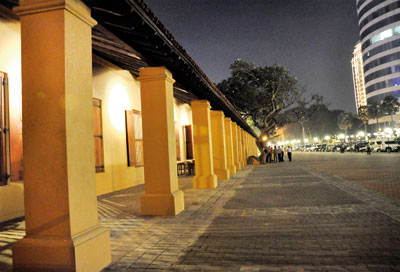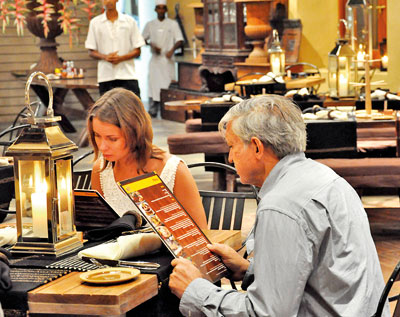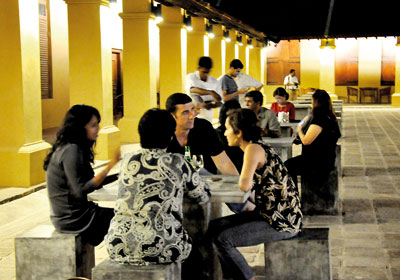Hidden by the high-rise buildings clustered in the bustling streets of Fort, lies a jewel of Sri Lanka’s past. Facing the towering concrete and glass facade of the twin towers of the World Trade Centre is a planed saffron structure that is rightfully a heritage site. The Old Dutch Hospital was constructed all of four centuries ago and is a resounding reminder of 17th century Dutch architecture with high ceilings, thick walls, large wide windows and terracotta tiled floors.
 |
| The old and the new: The hospital with its Dutch colonial archtecture of open courtyard and hefty pillars stands facing the World Trade Centre. |
Over recent years however, the ancient building has gone through more than a few changes. It was inaccessible to the public for several years which has resulted in a new generation of Sri Lankans today knowing little or nothing of its existence. That, however, may now change. A new project by the Ministry of Tourism together with the Urban Development Authority has brought it back into the limelight. The Old Dutch Hospital is now a restaurant and shopping precinct, with some of Sri Lanka’s popular brands opening outlets within its walls, occupying what were once medical wards for the Dutch East India Company personnel. The public is now free to stroll through the open courtyard flanked by the hefty pillars, wander in and out of cafes and shops, and admire the Dutch colonial architecture.
Deloraine Brohier, former board member of the Tourist Board and daughter of eminent historian and writer R. L. Brohier author of many books on Dutch history and architecture, shares her expertise on the history and architecture of the hospital. “The Dutch were very conscious of health and medical facilities and so they built hospitals in all their main cities in Ceylon. The only one that remains is the hospital in Colombo- Fort which was built in 1669,” she says. “Like most Dutch buildings it has stone blocks in front and terracotta tiles in the wards. People now apply floor polish on the terracotta tiles in their homes but back then the Dutch housewives would throw water over them to keep the dust down and cool the room, since they didn’t have fans at the time.”
She describes another cooling architectural feature as being the high ceilings and the large wide windows and doors being parallel to each other to allow a flow of air. “I’m not sure if most people notice but the drains are at a gradient. This was so that rain water would flow into tanks and be collected,” she adds explaining that back in the 17th century, plumbing was still to be invented.
Writing about 'The Seventeenth-Century Dutch Hospital In Colombo', authors C. G. Uragoda and K. D Paranavitana provide an interesting description of the building:
"The building appears hardly to have changed during the past two centuries. The design is a simple one, consisting of five wings, four of which are joined to form a square with a courtyard in the centre. The fifth wing constitutes the facade of the building and is situated in front of the square with a second courtyard intervening. The only part of the hospital with an upper floor is the front wing. However, this first floor is limited in extent, and appears like a compartment sitting atop the roof in the centre of the wing. A wooden staircase leads to this storey, which now has the appearance of a small hall. Its floor is made of wooden planks.
As with other old Dutch buildings in Sri Lanka, the walls are over 50 cm. thick and the teak beams are massive both in girth and length. These features of solid construction have undoubtedly ensured the survival of the building. A long and wide open verandah runs along the length of each wing, and is another characteristic of old Dutch architecture in the tropics. The high walls, large windows, and spacious verandahs provide a comfortable environment within, in contrast to the humid heat outside."
Renowned architect, Ashley De Vos- who restored the hospital in 1984, welcomes the Dutch Hospital’s renaissance adding that the shops and cafe have been constructed while preserving the original identity of the building. “Old buildings should not be left unused or else they will die. They must however be put to compatible use. Otherwise, if it’s incompatible with the building, structural changes will have to be made to suit the purpose.”
 |
 |
Prior to his reconstruction, Ashley recalls that the building was used as an Army mess. His collection of photographs reveals that the Dutch Hospital at the time was designated for demolition and in ruins. With some effort the building was gazetted as a heritage site and he was appointed to restore the hospital. Ashley’s painstaking restoration efforts went to the extent of recalling the solid teak beams used in the ceiling that had been removed earlier and chopped in half, and having them fixed back together and replaced.
Speaking about the present restoration process, Ashley says that the Dutch architecture has been preserved. “The building is strong enough as an entity,” he says, elaborating that the changes cannot take much away from the overall Dutch design. He is however, disappointed that the level of the terrace was elevated to be parallel with the verandah.
The Dutch Hospital is the first hospital built by the Dutch in Asia, he says, and was a midpoint along the lengthy journey from Dutch colonial outposts back home where the Dutch seafarers who fell ill could recuperate. It has even more of a historical significance as Dutch surgeon and botanist, Paul Hermann who served there during 1672 till 1679, was responsible for naming several Sri Lankan plants. Hermann was known as the father of botany in Sri Lanka. After Dutch times, the British also used it as a hospital for a while.
In its latest reincarnation, the premises now holds a restaurant, cafes, a bar, shops and a spa. Having its soft launch on December 2 was the Ministry of Crab, the first exclusive crab restaurant in Sri Lanka. Dharshan Munidasa, owner of Japanese cuisine restaurant chain Nihonbashi, partners with Sri Lanka’s star cricketers Kumar Sangakkara and Mahela Jayawardena to treat Sri Lankans to our export quality crab which ironically, is not freely available to locals. The restaurant opens its doors to customers tomorrow and will function between 6 p.m. and 11 p.m. Apart from the Ministry of Crab, a handful of other cafes such as the tea salon Heladiv Tea Club, the German pub styled Work in Progress (WIP) and ‘O’ bar by Lion Brewery have already been established as well. Barefoot, Colombo Jewellery Stores, Spa Ceylon and Odel are also located in the precinct.
In recent years, the building has served a number of purposes. it was the Fort Police station in the 1980’s and before that the Colombo Apothecaries. It was also significantly damaged in 1996 during the Central Bank bombing.
The Dutch Hospital undoubtedly has been a significant part of Sri Lankan history- having gone through many changes as the country evolved. It is now entering a new era, one that a public can enjoy and appreciate. |




